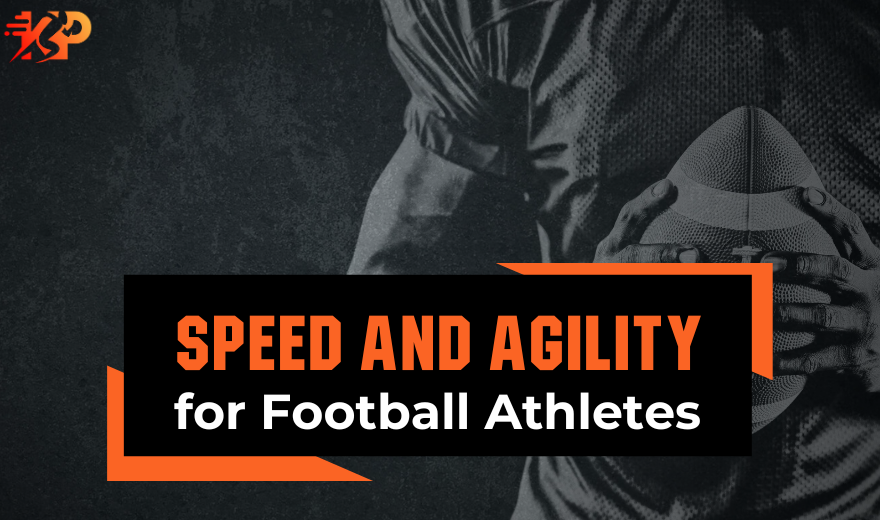Speed and Agility Training for Football Athletes
By Mark Keil, CSCS
Posted on August 4, 2024

In football, speed and agility are not merely advantageous but essential for players seeking to excel in a sport defined by rapid changes in pace and direction.
Integrating speed and agility into training regimens transforms good players into exceptional ones, enhancing their ability to react swiftly, maneuver proficiently, and execute plays precisely.
Speed in football is not just about running fast in a straight line; it involves quick bursts of acceleration and deceleration. Players must explode from a stationary position, often in response to an opponent’s movement or a teammate’s pass.
To be explosive, the athlete must have a powerful lower body with muscles that can generate significant force quickly.
Adequate deceleration is equally crucial, allowing players to stop abruptly and change direction without losing control.
The speed at which a player can react to various stimuli—such as the ball’s movement, an opponent’s actions, or a change in the game’s dynamics—can be the difference between winning and losing.
Rapid reaction time enables players to anticipate plays, intercept passes, and position themselves advantageously. Training drills that simulate game situations can enhance this aspect, sharpening a player’s reflexes and decision-making speed.
Once a player is in full stride, top-end speed becomes critical. Sprint training, interval runs, and technique-focused drills can help players maximize their top-end speed.
The Role of Agility in Football
Agility refers to the ability to change direction quickly and efficiently.
Football is a game of constant movement. Players must weave through opponents, navigate tight spaces, and adjust their path based on the game’s flow.
Agility drills, such as cone drills, ladder drills, and shuttle runs, improve a player’s ability to make sharp, controlled turns without losing momentum.
Agility also encompasses balance and coordination, which are crucial for maintaining control during quick movements. A player with excellent balance can stay in control even when making sudden changes in direction or under physical pressure from an opponent.
Coordination ensures that movements are smooth and synchronized, reducing the risk of injury and improving overall efficiency.
Fast footwork is a hallmark of agile players. It involves rapid, precise foot movements to navigate tight spaces, evade defenders, and maintain control.
Drills emphasizing quick feet, such as ladder drills, lateral shuffles, and plyometric exercises, can enhance this skill and make players more challenging to mark.
The Synergy of Speed and Agility in Football
The combination of speed and agility allows players to create space and opportunities on the field. A fast, agile player can outmaneuver defenders, opening passing lanes and creating opportunities.
Speed and agility are equally crucial for defenders. A defender with these attributes can close down attackers quickly, recover from mistakes, and stay with their mark. Agility allows defenders to change direction swiftly, while speed enables them to catch up with fast attackers. This combination makes it difficult for opponents to break through the defense and score.
Football is a game of transitions—shifting from defense to attack and vice versa. Speed and agility facilitate rapid transitions, allowing players to move quickly from one phase of play to another.
Training for Speed and Agility in Football
Plyometric Training
Plyometrics involves explosive exercises that enhance power, speed, and agility. Exercises such as box jumps, depth jumps, and bounding improve the explosive strength of the lower body, which is essential for rapid acceleration and powerful changes in direction.
Sprint Drills
Sprint drills, including varying distances and intensities, help improve top-end speed and acceleration. Incorporating drills that mimic game situations, such as sprints with sudden stops and starts, can enhance the specific speed requirements of football.
Agility Drills
Agility drills, such as cone drills, ladder drills, and shuttle runs, improve a player’s ability to change direction quickly and efficiently. These drills also enhance coordination and balance, making players more adept at navigating tight spaces and avoiding tackles.
Strength Training
Strength training, particularly for the lower body, is crucial for developing the power needed for speed and agility. Squats, lunges, deadlifts, and leg presses build the necessary muscle strength to generate explosive movements and maintain stability during quick changes in direction.
Flexibility and Mobility
Flexibility and mobility exercises ensure that muscles and joints can move through their full range of motion without restriction. A proper range of motion reduces the risk of injury and allows for more fluid and efficient movements. Stretching routines and dynamic warm-ups enhance flexibility and mobility.
Psychological Aspects of Speed & Agility
Confidence and Mental Toughness
Speed and agility also contribute to a player’s psychological edge. Knowing they can outpace or outmaneuver opponents boosts confidence, allowing players to perform more assertively. Mental toughness is enhanced as players push through the physical demands of speed and agility training, developing resilience and a competitive mindset.
Decision Making
Fast, agile players often have to make quick decisions under pressure. Processing information rapidly and executing movements efficiently is a cognitive skill that can be developed alongside physical training.
Decision-making drills that simulate game scenarios help players improve their ability to make intelligent choices quickly.
Conclusion
Integrating speed and agility into football training regimens is beneficial and essential for optimizing performance.
These attributes enhance a player’s ability to react swiftly, move efficiently, and precisely execute plays. By focusing on developing speed and agility, players can transform their game and gain a competitive edge that sets them apart on the field.
Through dedicated training, including plyometrics, sprint drills, agility exercises, and strength training, players can harness the power of speed and agility, elevating their performance to new heights.
Training Resources



